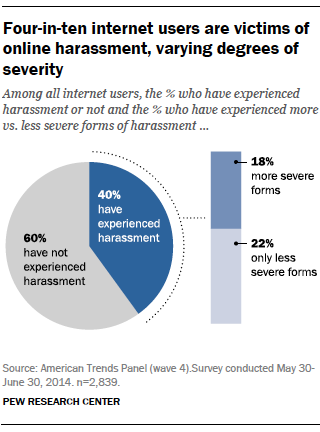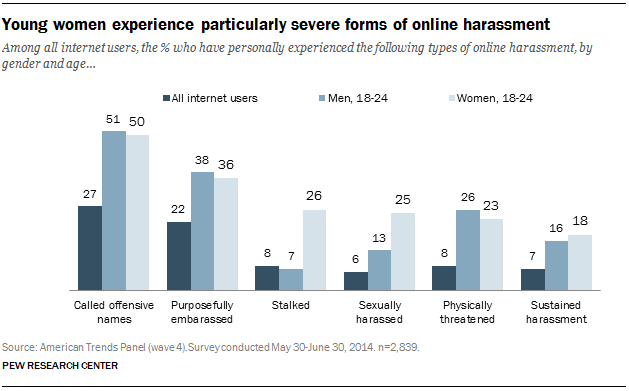Summary of Findings
Harassment—from garden-variety name calling to more threatening behavior— is a common part of online life that colors the experiences of many web users. Fully 73% of adult internet users have seen someone be harassed in some way online and 40% have personally experienced it, according to a new survey by the Pew Research Center.
Pew Research asked respondents about six different forms of online harassment. Those who witnessed harassment said they had seen at least one of the following occur to others online:
- 60% of internet users said they had witnessed someone being called offensive names
- 53% had seen efforts to purposefully embarrass someone
- 25% had seen someone being physically threatened
- 24% witnessed someone being harassed for a sustained period of time
- 19% said they witnessed someone being sexually harassed
- 18% said they had seen someone be stalked
Those who have personally experienced online harassment said they were the target of at least one of the following online:
- 27% of internet users have been called offensive names
- 22% have had someone try to purposefully embarrass them
- 8% have been physically threatened
- 8% have been stalked
- 7% have been harassed for a sustained period
- 6% have been sexually harassed
In Pew Research Center’s first survey devoted to the subject, two distinct but overlapping categories of online harassment occur to internet users. The first set of experiences is somewhat less severe: it includes name-calling and embarrassment. It is a layer of annoyance so common that those who see or experience it say they often ignore it.
The second category of harassment targets a smaller segment of the online public, but involves more severe experiences such as being the target of physical threats, harassment over a sustained period of time, stalking, and sexual harassment.
Of those who have been harassed online, 55% (or 22% of all internet users) have exclusively experienced the “less severe” kinds of harassment while 45% (or 18% of all internet users) have fallen victim to any of the “more severe” kinds of harassment. Online harassment tends to occur to different groups in different environments with different personal and emotional repercussions.
Online harassment tends to occur to different groups in different environments with different personal and emotional repercussions.
In broad trends, the data show that men are more likely to experience name-calling and embarrassment, while young women are particularly vulnerable to sexual harassment and stalking. Social media is the most common scene of both types of harassment, although men highlight online gaming and comments sections as other spaces they typically encounter harassment. Those who exclusively experience less severe forms of harassment report fewer emotional or personal impacts, while those with more severe harassment experiences often report more serious emotional tolls.
Key findings
Who is harassed: Age and gender are most closely associated with the experience of online harassment. Among online adults:
Young adults, those 18-29, are more likely than any other demographic group to experience online harassment. Fully 65% of young internet users have been the target of at least one of the six elements of harassment that were queried in the survey. Among those 18-24, the proportion is 70%.
Young women, those 18-24, experience certain severe types of harassment at disproportionately high levels: 26% of these young women have been stalked online, and 25% were the target of online sexual harassment. In addition, they do not escape the heightened rates of physical threats and sustained harassment common to their male peers and young people in general.

 Overall, men are somewhat more likely than women to experience at least one of the elements of online harassment, 44% vs. 37%. In terms of specific experiences, men are more likely than women to encounter name-calling, embarrassment, and physical threats.
Overall, men are somewhat more likely than women to experience at least one of the elements of online harassment, 44% vs. 37%. In terms of specific experiences, men are more likely than women to encounter name-calling, embarrassment, and physical threats.
Beyond those demographic groups, those whose lives are especially entwined with the internet report experiencing higher rates of harassment online. This includes those who have more information available about them online, those who promote themselves online for their job, and those who work in the digital technology industry.
Perpetrators of online harassment: A plurality of those who have experienced online harassment, 38%, said a stranger was responsible for their most recent incident and another 26% said they didn’t know the real identity of the person or people involved. Taken together, this means half of those who have experienced online harassment did not know the person involved in their most recent incident.1
Where harassment occurs: Online harassment is much more prevalent in some online environments than in others. Asked to recall where their most recent experience took place:
- 66% of internet users who have experienced online harassment said their most recent incident occurred on a social networking site or app
- 22% mentioned the comments section of a website
- 16% said online gaming
- 16% said in a personal email account
- 10% mentioned a discussion site such as reddit
- 6% said on an online dating website or app
Women and young adults were more likely than others to experience harassment on social media. Men—and young men in particular—were more likely to report online gaming as the most recent site of their harassment.
Responses to online harassment: Among those who have experienced online harassment, 60% decided to ignore their most recent incident while 40% took steps to respond to it. Those who responded to their most recent incident with online harassment took the following steps:
- 47% of those who responded to their most recent incident with online harassment confronted the person online
- 44% unfriended or blocked the person responsible
- 22% reported the person responsible to the website or online service
- 18% discussed the problem online to draw support for themselves
- 13% changed their username or deleted their profile
- 10% withdrew from an online forum
- 8% stopped attending certain offline events or places
- 5% reported the problem to law enforcement
Regardless of whether a user chose to ignore or respond to the harassment, people were generally satisfied with their outcome. Some 83% of those who ignored it and 75% of those who responded thought their decision was effective at making the situation better.
Those with more “severe” harassment experiences responded differently to their most recent incident with harassment than those with less “severe” experiences. Those who have ever experienced stalking, physical threats, or sustained or sexual harassment were more likely to take multiple steps in response to their latest incident than those who have only experienced name-calling and embarrassment, 67% vs. 30%. They are more likely to take actions like unfriending or blocking the person responsible, confronting the person online, reporting the person to a website or online service, changing their username or deleting their profile, and ending their attendance at certain offline events and places.
After-effects of online harassment: Asked how upsetting their most recent experience with harassment was, the responses ran a spectrum from being quite jarring to being of no real consequence:
- 14% of those who have experienced online harassment found their most recent incident extremely upsetting
- 14% found it very upsetting
- 21% said it was somewhat upsetting
- 30% reported it was a little upsetting
- 22% found it not at all upsetting
Taken together, half found their most recent experience with online harassment a little or not at all upsetting. But a significant minority, 27%, found the experience extremely or very upsetting.
Women were more likely than men to find their most recent experience with online harassment extremely or very upsetting—38% of harassed women said so of their most recent experience, compared with 17% of harassed men.
Again, there were differences in the emotional impact of online harassment based on the level of severity one had experienced in the past. Some 37% of those who have ever experienced sexual harassment, stalking, physical threats, or sustained harassment called their most recent incident with online harassment “extremely” or “very” upsetting compared with 19% of those who have only experienced name-calling or embarrassment.
When it comes to longer-term impacts on reputation, there is a similar pattern. More than 80% of those who have ever been victim of name-calling and embarrassment did not feel their reputation had been hurt by their overall experience with online harassment. Those who experienced physical threats and sustained harassment felt differently. About a third felt their reputation had been damaged by their overall experience with online harassment. Overall, 15% of those who have experienced online harassment said it impacted their reputation.
 Perceptions of online environments: To explore the context that informs online harassment, respondents were asked about their general perceptions of and attitudes toward various online environments.
Perceptions of online environments: To explore the context that informs online harassment, respondents were asked about their general perceptions of and attitudes toward various online environments.
Fully 92% of internet users agreed that the online environment allows people to be more critical of one another, compared with their offline experiences. But a substantial majority, 68%, also agreed that online environments allow them to be more supportive of one another. Some 63% thought online environments allow for more anonymity than in their offline lives.
 Respondents were asked whether they thought a series of online platforms were more welcoming toward men, more welcoming toward women, or equally welcoming to both sexes. While most online environments were viewed as equally welcoming to both genders, the starkest results were for online gaming. Some 44% of respondents felt the platform was more welcoming toward men.
Respondents were asked whether they thought a series of online platforms were more welcoming toward men, more welcoming toward women, or equally welcoming to both sexes. While most online environments were viewed as equally welcoming to both genders, the starkest results were for online gaming. Some 44% of respondents felt the platform was more welcoming toward men.
About this survey
Data in this report are drawn from the Pew Research Center’s American Trends Panel, a probability-based, nationally representative panel. This survey was conducted May 30 – June 30, 2014 and self-administered via the internet by 2,849 web users, with a margin of error of plus or minus 2.4 percentage points. For more information on the American Trends Panel, please see the Methods section at the end of this report.


 Interactive
Interactive